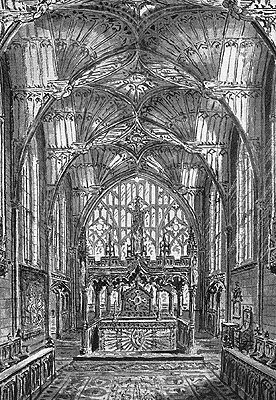
EBK Home
Kingdoms
Royalty
Saints
Pedigrees
Archaeology
King Arthur
Mail David
Glastonbury Shrines
Part 8: Local Somerset Saints
 Being one of the Britain's greatest
homes to pious and holy men, it is not surprising that several of
Glastonbury's monks were revered as saints. Apart from the widespread cult
of St. Dunstan, there was also more
local support for the worship of St. Guthlac of Glastonbury and St.
Bertwald of Ramsbury. The former was a Glastonbury monk who, though he
rose to become the Bishop of Ramsbury & Sonning, chose to be buried in
his old monastery. St. Guthlac was Abbot of Glastonbury from AD 824 to
851. Unfortunately, the monks who encouraged his cult at Glastonbury were
working under the misapprehension that they held the bones of St. Guthlac
of Crowland (in East Anglia) and set up a shrine to rival that at Crowland
Abbey. St. Guthlac of Glastonbury had obviously been long forgotten.
Being one of the Britain's greatest
homes to pious and holy men, it is not surprising that several of
Glastonbury's monks were revered as saints. Apart from the widespread cult
of St. Dunstan, there was also more
local support for the worship of St. Guthlac of Glastonbury and St.
Bertwald of Ramsbury. The former was a Glastonbury monk who, though he
rose to become the Bishop of Ramsbury & Sonning, chose to be buried in
his old monastery. St. Guthlac was Abbot of Glastonbury from AD 824 to
851. Unfortunately, the monks who encouraged his cult at Glastonbury were
working under the misapprehension that they held the bones of St. Guthlac
of Crowland (in East Anglia) and set up a shrine to rival that at Crowland
Abbey. St. Guthlac of Glastonbury had obviously been long forgotten.
St. Edgar the Peacemaker was King of Wessex and a great patron of Glastonbury from where his great advisor, St. Dunstan, hailed. He chose to be buried there, in the Chapter House by the door to the church, upon his death on 8th July AD 975. It is claimed his body was found to be incorrupt and blood flowed when it was cut during his tomb's opening in 1052. His relics were interred with those of Saints Apollinaris and Vincent which he himself had presented to the Abbey in a large gold and silver shrine decorated with ivory images. They were placed on display in the Edgar Chapel at the far eastern end of the Abbey Church.
The Abbey also claimed to be the burial place of St. Gildas the Wise, the famous pseudo-historian who wrote De Excidio Britanniae. Gildas hailed from the Clyde Valley in modern Scotland. He is known to have lived in Wales, but he is also claimed as a resident of Glastonbury and Rhuys in Brittany. Both displayed his shrine and the latter can still be seen in the local parish church. However, the Breton saint appears to have really been one St. Gueltus who was misidentified as the more famous Gildas. There therefore seems little reason to doubt the Glastonbury story that St. Gildas retired to a small hermitage on the site where the church of Leigh-in-Street now stands. Here he died and was later brought to the nearby Abbey for burial.
Click to Start Again
